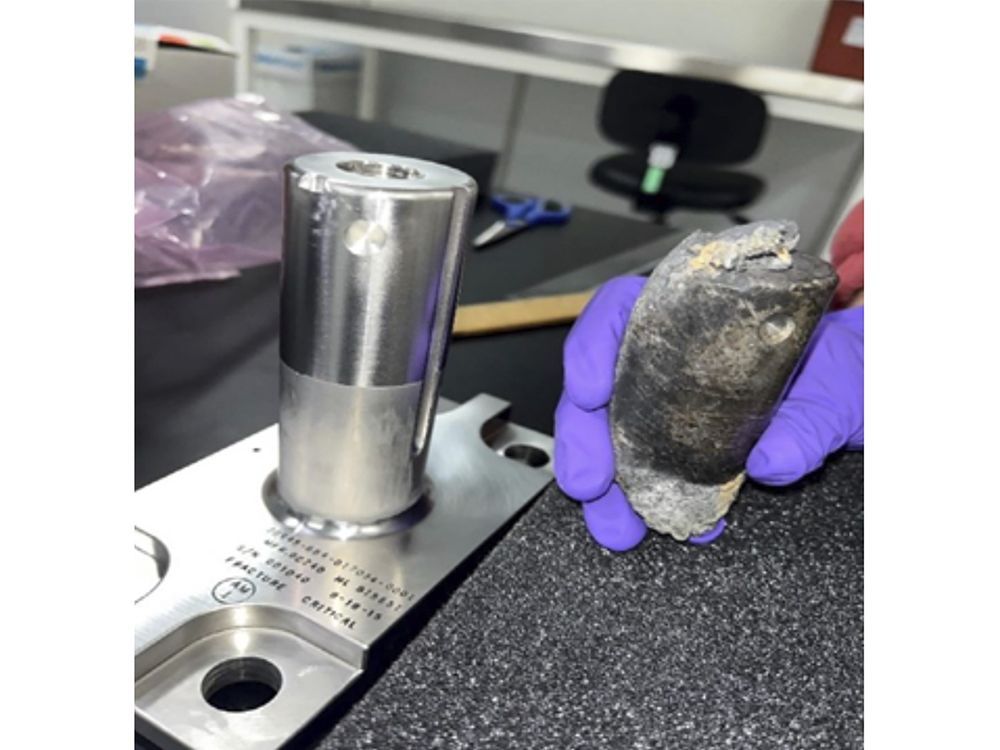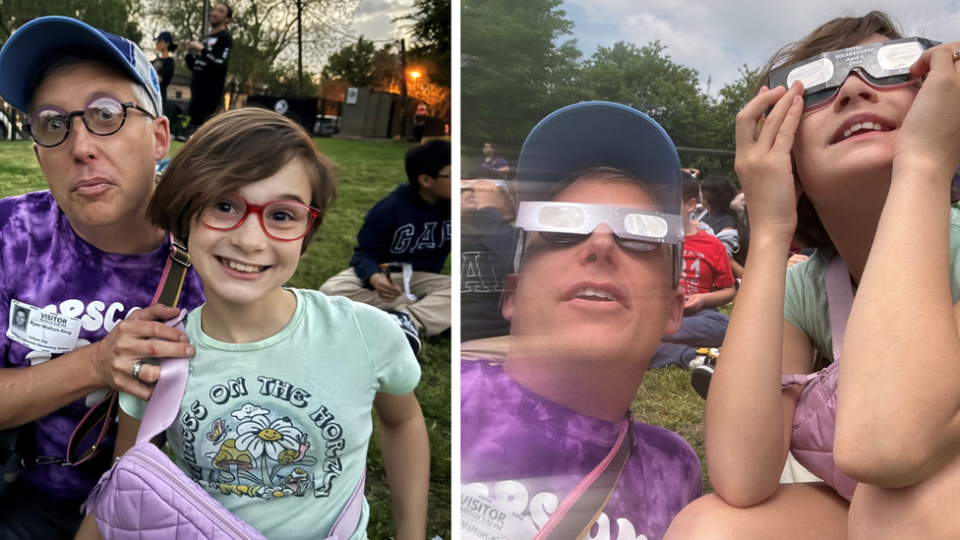Science
'Frozen in place' fossils reveal dinosaur-killing asteroid struck in spring – Livescience.com
Spring is a time for budding flowers, tender green leaves and baby animals. But 66 million years ago, that gentle season instead brought mass death and carnage from Earth’s catastrophic impact with a massive space rock.
Earth was forever changed after an enormous asteroid smashed into our planet at the end of the Cretaceous period (145 million to 66 million years ago), triggering a global extinction that wiped out 76% of life on Earth, including all nonavian dinosaurs, pterosaurs and most marine reptiles. Scientists recently pinpointed the season of the disaster and linked it to springtime in the Northern Hemisphere, after analyzing fossilized animals that died minutes after the impact.
They found the fossils at a site called Tanis, where a river once flowed through what is now North Dakota. After the asteroid struck near Mexico’s Yucatán Peninsula, the shock sent powerful waves roaring upstream toward Tanis, sweeping up fish and forest creatures and burying them alive under layers of soil. When the water subsided, it left behind an astonishingly well preserved 3D snapshot of destruction, captured within 30 minutes after the asteroid struck, the researchers reported in a new study. Fossils of those filter-feeding fish also held clues about their seasonal growth cycles, hinting that spring had sprung when the fish died and the dinosaurs‘ reign abruptly ended.
Related: The 5 mass extinction events that shaped the history of Earth
The moment of mass, instantaneous death preserved in Tanis, with broken and splintered fish fossils wrapped around tree branches and strewn in all directions, “was like the worst car crash you’ve ever seen, frozen in place,” said lead study author Melanie During, a doctoral candidate in the Department of Organismal Biology at Uppsala University in Sweden. It was also “the most spectacular deposit I’ve ever seen in my life,” During said at a news conference on Feb. 22.
During excavated Cretaceous fish at Tanis in August 2017, spending two weeks digging out fossils of paddlefish and sturgeons. Fish skeletons — even after fossilizing — retain records of an animal’s growth, which depends on seasonal food availability. By mapping these patterns in bone cell growth and density, the scientists hoped to identify which part of the growth cycle the Tanis fish had reached when they died, which could indicate what time of year it was.
The study authors scanned the fossils using synchrotron X-ray imaging, nondestructively imaging and reconstructing the fossils in 3D. They found tiny glass balls called spherules embedded in the fishes’ gills; these small spheres fused from ultrahot sediments when the asteroid struck and ejected towering plumes of dirt from the impact crater. Particles flew into Earth’s atmosphere and beyond and then rained back down on the planet as glassy beads.
Other researchers who studied Tanis’ Cretaceous death pit calculated that impact spherules would have fallen between 15 and 30 minutes after the asteroid crashed into Earth. Because spherules were in the fishes’ gills but had not been swallowed, the fish were likely buried alive immediately after inhaling the glassy beads — within 30 minutes after the asteroid impact, according to the new study.
Related: Photos: The freakiest-looking fish
Synchrotron scans also revealed signs of cell growth fluctuations in the fossilized bones, taking place over seven years. Much as trees mark the passage of time in the accumulation of rings, which are visible in cross sections of their trunks, fish add layers to their bones as they age, with growth peaking by the end of the summer and then declining over the winter. When the fish died, they were just entering a time of significant bone growth — which coincided with spring, study co-author Dennis Voeten, a research engineer at Uppsala University’s Department of Organismal Biology, said at the news conference.
“I think it makes sense to everyone that when a fish eats, its bone grows,” During told Live Science in an email. However, seeing this quantified in Cretaceous fossils “is really new and unbelievably informative for future studies,” she said.

Records of carbon isotopes, or variations of the element carbon, from one of the fishes further confirmed that the fish died in springtime, the scientists wrote in the study. Like bone growth, “the carbon isotope record shows a distinct cyclic pattern, where high values reflect high productivity of plankton,” which was the main food for paddlefish, said study co-author Jeroen van der Lubbe, an assistant professor in the Department of Earth Sciences at the Vrije Universiteit Amsterdam in the Netherlands. Plankton abundance is typically highest in summer; the isotope analysis showed that plankton productivity hadn’t yet peaked for the year, so the researchers concluded that the fish perished in the spring, van der Lubbe said at the news conference.
The timing of the asteroid impact likely had far-reaching consequences, with some species on Earth being better equipped to weather the disaster simply because of what season it was in their part of the world, the researchers reported.
Organisms in the Northern Hemisphere, where spring was warming things up, were likely just emerging and were primed for growth and reproduction after the cold winter months. They would have been exposed and had fewer resources, having already depleted whatever stored reserves helped them survive the winter. A springtime ecosystem could therefore have been more vulnerable to the immediate effects of the impact than plants and animals in the Southern Hemisphere that were hunkering down for winter, During said.
“After the impact, a sudden cooling of unknown duration took place — which, of course, had its own influence on the extinction pattern,” During said. “Nevertheless, it is clear that the organismal groups that did not survive that catastrophic spring/autumn would not have been around to fight in the subsequent nuclear winter to begin with.”
The findings were published online Wednesday (Feb. 23) in the journal Nature.
Originally published on Live Science.
Science
NASA is seeking a faster, cheaper way to bring Mars samples to Earth – CityNews Toronto


CAPE CANAVERAL, Fla. (AP) — NASA’s plan to bring samples from Mars back to Earth is on hold until there’s a faster, cheaper way, space agency officials said Monday.
Retrieving Mars soil and rocks has been on NASA’s to-do list for decades, but the date kept moving forward, as costs ballooned. A recent independent review put the total cost at $8 billion to $11 billion, with an arrival date of 2040, about a decade later than advertised.
NASA Administrator Bill Nelson said that’s too much and too late. He’s asking private industry and the space agency’s centers to come up with other options to revamp the project. With NASA facing across-the-board budget cuts, he wants to avoid gutting other science projects to finance the Mars sample project.
“We want to get every new and fresh idea that we can,” he said at a news conference.
NASA’s rover Perseverance already has gathered 24 core samples in tubes since landing in 2021 at Mars’ Jezero Crater, an ancient river delta. The goal is more than 30 samples to scour for possible signs of ancient Martian life.
The space agency wants to get at least some of the collected samples to Earth sometime in the 2030s for no more than the $7 billion. That would require a spacecraft that goes to Mars to get the tubes and launches off the planet. Then it must rendezvous with yet another spacecraft that would bring the samples to Earth.
NASA’s science mission chief, Nicky Fox, refused to speculate at the news conference when the samples might arrive at Earth, given a new program and timeline, or even how many samples might be returned. That information will be included in any proposals, she said.
“We’ve never launched from another planet, and that’s actually what makes Mars sample return such a challenging and interesting mission,” Fox said.
Scientists are eager to analyze pristine samples from Mars in their own labs, far superior to the kind of rudimentary testing done by spacecraft at the red planet. It will take such in-depth testing to confirm any evidence of microscopic life dating back billions of years when water flowed on the planet, according to NASA.
The samples will help NASA decide where astronauts go on Mars in the 2040s, Nelson said.
NASA’s Jet Propulsion Laboratory in Pasadena, California, had been in charge of the sample project. It was hit by hundreds of layoffs earlier this year due to all the budget cutbacks. Nelson is seeking ideas from across the space agency, with the revamped program more spread out.
NASA hopes to receive any ideas by late fall.
___
The Associated Press Health and Science Department receives support from the Howard Hughes Medical Institute’s Science and Educational Media Group. The AP is solely responsible for all content.
Marcia Dunn, The Associated Press
Science
NASA confirms mystery object that crashed through roof of Florida home came from space station – Toronto Sun


Article content
NAPLES, Fla. (AP) — NASA confirmed Monday that a mystery object that crashed through the roof of a Florida home last month was a chunk of space junk from equipment discarded at the International Space Station.
Article content
The cylindrical object that tore through the home in Naples on March 8 was subsequently taken to the Kennedy Space Center in Cape Canaveral for analysis.
Article content
The space agency said it was a metal support used to mount old batteries on a cargo pallet for disposal. The pallet was jettisoned from the space station in 2021, and the load was expected to eventually fully burn up on entry into Earth’s atmosphere, but one piece survived.
The chunk of metal weighed 1.6 pounds (0.7 kilograms) and was 4 inches (10 centimetres) tall and roughly 1 1/2 inches (4 centimetres) wide.
Homeowner Alejandro Otero told television station WINK at the time that he was on vacation when his son told him what had happened. Otero came home early to check on the house, finding the object had ripped through his ceiling and torn up the flooring.
“I was shaking. I was completely in disbelief. What are the chances of something landing on my house with such force to cause so much damage,” Otero said. “I’m super grateful that nobody got hurt.”
Share this article in your social network
Science
Total solar eclipse: Continent watches in wonder – Yahoo News Canada
Across Mexico, the US and Canada, inside a ribbon of land stretching 155 miles wide but more than 4,000 miles long, tens of millions of people craned their necks, tilted their heads to the sky and watched in wonder as the day turned to night.
What many saw on Monday was a phenomenon like no other: the Moon moving between the Earth and the Sun, extinguishing its light in a total solar eclipse.
The path of totality spanned the continent, beginning over the warm sands of a Mexican beach town and darkening the skies above the crashing waters of Niagara Falls before ending its journey on the shores of Canada’s Newfoundland.
It left a sense of awe in its wake, a reminder of our planet’s place in the universe.
The eclipse was first seen around Mazatlán, Mexico, on the country’s western shores at 11:07 local time (18:07 GMT).
At first, the Moon’s outer edge seemed to just be touching the Sun. Then it devoured more and more until cheers erupted as all finally went dark – save for the silvery glow of the “corona” effect of the Sun around the Moon’s outline.

A thousand miles away in Dallas, Texas, 11-year-old Ady Walton-King was waiting, weeks of pent-up excitement ready to burst.
She had learned all about the eclipse in her fifth-grade class at Dallas Academy and on Monday morning she laced up her shoes and tucked four pairs of eclipse glasses into her pink purse – one for herself, one for each parent and one for her little sister, Abigail.
Just before it started, Ady sat down beside her dad, Ryan, on a school field in central Dallas and lifted her gaze upward.
And then it happened.
It all felt slow, she said, as she described the Texas afternoon turning dark. “It looked like the Moon was biting the Sun, but without the teeth marks.”
Clouds slid in and out, occasionally blocking the eclipse from view until the Sun had vanished, nothing left but little flares of light around the Moon.
“I didn’t think it would be like that,” Ady said. “It was really dark out. I thought it would be like evening dark, but it was pretty close to pitch black.”
The temperature dropped suddenly and, just as she had been taught, animals fell silent.
“As it started to get lighter the crickets were there, and the birds started singing. It was really crazy,” she said. “I’m sad it’s over.”
From there, the eclipse moved on, carving its path north-east through the United States.
For some, the solar phenomenon was marked by a personal milestone, with hundreds of Americans joining one of several mass wedding events dotted across the path of totality.


In Russellville, Arkansas, 300 couples from across the country signed up, saying “I do” just before the sky went black. As the sky brightened, the group cut wedding cakes and danced – all part of the aptly named Total Eclipse of the Heart festival.
Following the Moon one state over, in Ellsinore, Missouri, was amateur astronomer Darcy Howard, who had driven from her home in central Arkansas to be sure bad weather didn’t block her view.
She had seen many eclipses before today, two totals, one annular and two partials. “Each one has its own fingerprint,” she said.
Totality today, at around 13:56 local time (18:56 GMT) brought an “eerie twilight”, Ms Howard said, with dusky colours dotted all along the horizon. The corona was nearly as bright as a full moon. “The sense of other-worldliness was all around,” she said.
The 70-year-old has loved the cosmos since her childhood, since her father showed her the Big Dipper, the North Star and the Milky Way, and bought her her first telescope.
“I was hooked,” she said. “I can look through a telescope and see Jupiter… I can see Saturn. And when I see that in space, I know all is right with the world.”


By 15:13 local time (20:13 GMT), the total eclipse had plunged the midwestern state of Ohio into darkness.
In Cleveland, where eclipse-watchers were graced by clear skies, the Sun’s corona was clearly visible, a brilliant halo framing the Moon.
The stars came out in the middle of the day, a sight met with cheers and fireworks, a mid-April New Years Eve.
Many big American cities were not lucky enough to be on the path of totality – but the spectacles were still awe-inspiring. In New York, hundreds of people crowded on to the viewing platform of the Edge skyscraper in Manhattan to see what they could see.
They did not leave disappointed as the sun shrank to a crescent-like sliver of light that cast an unearthly pale gloom over the city.


Tourists had crowded along both sides of the border at Niagara Falls, where the eclipse path crossed from the US into Canada.
Here, the weather offered a formidable challenge, with thick grey clouds mostly obscuring the sky from view.
But just in time for totality – to the audible delight of the crowd – the clouds parted to reveal the black-hole Sun.
Nearby, on a Niagara City Cruise, 309 people celebrated by record-breaking – dressing up as the Sun to break the Guinness World Record for “Largest gathering of people dressed as the Sun”.
The relentless motion of the heavenly bodies meant that the phenomenon did not last long, and it was Montreal that next got its chance to be plunged into temporary night.
In Montreal, 20,000 people crowded onto a field on McGill University’s campus for an event held by the school’s Trottier Space Institute.
“We had been expecting 8,000,” programme administrator Caroina Cruz-Vinaccia said after. The weather was perfect, clear and bright skies. At the moment of totality, the crowd erupted at once, she said.
“I still can’t quite find the words for how cool this was,” she said. “We’re still coming down.”
Crowds were smaller on Newfoundland’s Fogo Island, on Canada’s east coast – one of the last places the totality could be viewed.
Bethany Downery, a Newfoundland native who works for the European Space Agency, tuned into the spectacular view from the Fogo Island Inn, nestled right against the Atlantic Ocean.
The skies were overcast, she said, but the clouds moved miraculously in time to catch near totality.
And with that, a day of collective wonder and celebration reached its conclusion. But it had left a permanent mark on many of those who had witnessed it.
In Dallas, a few thousand miles back along the path, Ady Walton-King was making plans.
Texas will not be in the path of totality again for another 300 years, so she’ll have to travel for the next one in North America, in 2044.
And by that time, she’ll be even more of an expert on total eclipses. “I want to be a scientist by the time that happens,” she said.
– With additional reporting from Brandon Livesay, Nada Tawfik, Nadine Yousif and Helena Humphrey


More on the solar eclipse
-
Media20 hours ago
DJT Stock Plunges After Trump Media Files to Issue Shares
-
Business19 hours ago
FFAW, ASP Pleased With Resumption of Crab Fishery – VOCM
-
Media19 hours ago
Marjorie Taylor Greene won’t say what happened to her Trump Media stock
-
Business20 hours ago
Javier Blas 10 Things Oil Traders Need to Know About Iran's Attack on Israel – OilPrice.com
-
Media18 hours ago
Trump Media stock slides again to bring it nearly 60% below its peak as euphoria fades – National Post
-



 Politics20 hours ago
Politics20 hours agoIn cutting out politics, A24 movie 'Civil War' fails viewers – Los Angeles Times
-
Art21 hours ago
It’s Time to Remove Father Rupnik’s Art – National Catholic Register
-
Investment21 hours ago
A Once-in-a-Generation Investment Opportunity: 1 Top Artificial Intelligence (AI) Stock to Buy Hand Over Fist in April … – Yahoo Finance




